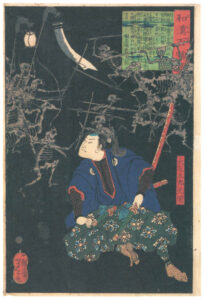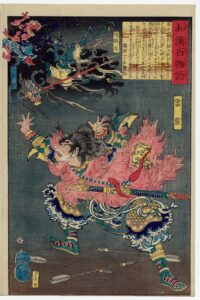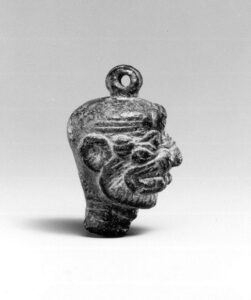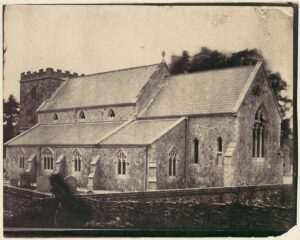 Stories of ghosts, demons, and other horrors are common to all cultures, and most cultures around the world have art portraying the supernatural. Since ancient times, Japan’s religion and culture has been deeply bound with ghosts, called yūrei. Both feared and revered, yūrei are part of the deep magic; a foundational belief that humans have a god inside of them.
Stories of ghosts, demons, and other horrors are common to all cultures, and most cultures around the world have art portraying the supernatural. Since ancient times, Japan’s religion and culture has been deeply bound with ghosts, called yūrei. Both feared and revered, yūrei are part of the deep magic; a foundational belief that humans have a god inside of them.
Tsukioka Yoshitoshi, born in 1839 in Japan, is known as one of the last great masters of the Japanese woodblock print. One of his masterpieces a series of works, 100 Ghost Stories from China and Japan. The series, created in 1865, includes images of skeletons, ghosts, and other supernatural creatures. One well-known print is Japanese samurai warrior, Oya Taro Mitsukuni watching a battle scene between armies of skeletons.

Leizhen (Raishin), MFA Boston
The Museum of Fine Arts in Boston (MFA) owns Leizhen (Raishin), from the series. The work, signed by Ikkaisai Yoshitoshi ga, was purchased by William Sturgis Bigelow in 1911 and then gifted to the MFA. Bigelow was a prominent American collector of Japanese art. He lived in Japan for seven years. The Japanese government authorized him and two other Americans to explore parts of Japan that had been closed to outside viewers for centuries. During his time there, he acquired valuable art, including the mandala from the Hokke-do of Tōdai-ji, one of the oldest Japanese paintings to ever leave Japan. Bigelow donated approximately 75,000 objects of Japanese art to Boston MFA. Due to the huge donation, the still has the largest collection of Japanese art anywhere outside Japan.
Perhaps even more haunting is a series of fourteen works, the Pinturas Negras (Black Paintings), created between 1819 and 1823 by Spanish painter Francisco Goya. The works depict dark themes that reflected Goya’s own fears and his bleak view of humanity, in part due to the fact that the Spanish master was going deaf. At the age of 72, Goya moved into a home outside of Madrid known as La Quinta del Sordo (the Deaf Man’s Villa). The previous owner was deaf, and Goya was nearly deaf by the time he moved into the home. During this despairing time, Goya painted a series of unsettling works, such as murals on the walls of his house. They were eventually transferred to canvas.

Witches’ Sabbath, El Prado
One of the most macabre is the work now known (Goya did not title the murals) as the Witches’ Sabbath (El Aquelarre) or The Great He-Goat (El Gran Cabrón). Like most of the other works in the series, it was painted with dark and earth-toned colors. The painting depicts a witches Sabbath attended by the Devil in the form of a goat. The He-Goat appears as a silhouette painted entirely in black, except for one eye. Facing the demonic creature is a coven of witches and warlocks, portrayed with hideous features. The series of works was acquired by the Baron Emile d’Erlanger when he purchased the “Quinta” in 1873. He had the murals transferred to canvas, but they suffered great damage. The Baron ultimately donated the works to the government of Spain, which in turn moved them to the Prado, a national museum located in Madrid, to be publicly viewed.
The portrayal of devils and demons in works of art dates back millennia. Featured in The Exorcist, Pazuzu is the main antagonist who is exorcized from its victim. But the demon was not just the creation of the author of the The Exorcist, William Peter Blatty. The demon derives from Assyrian and Babylonian mythology, where it was considered the king of the demons of the wind, and the son of the god Hanbi.

Pendant of Pazuzu, Metropolitan Museum of Art
On display at the Metropolitan Museum of Art (the Met) is a small pendant of the demon, dating from the 8th to 7th century BC. The pendant has bulging eyes, bulbous forehead protrusions, and short beard that rings the snarling open mouth, atop an incongruously thin neck. These are his unmistakable features.
According to the Met, Pazuzu appears on many plaques and amulets, sometimes as a figure with wings and a scorpion tail. The earliest image of Pazuzu dates to the late 8th century B.C., relatively late in the history of demonic imagery in Mesopotamia. The museum states that this was a period when the Assyrian royal administration was intensely focused on collecting magical knowledge and studying the supernatural world, and priests and exorcists were actively engaged in codifying these systems of knowledge. As a result, a rich variety of magical images and texts from Assyria in this period have survived. The pendant was sold at Hôtel Drouot, Paris, on May 19-20, 1987, and eventually it was acquired by the museum in 1993, purchased at Sotheby’s New York, on June 12, 1993.
In addition to the demonic pendant, the Met owns other spooky art, including this photograph of a ghostly apparition.